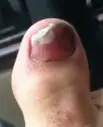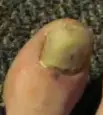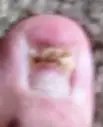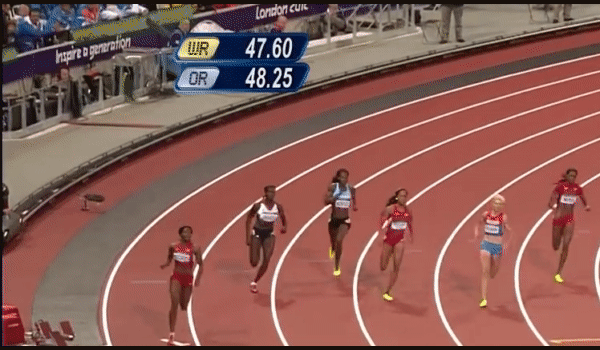runners toe
AUTHOR: Marc Mitnick DPMREVIEWED BY: Podiatric Medical Review Board
home --> runners toe
WHAT IS RUNNERS TOE
If you are a serious runner or participate in any number of sports where you are either running or constantly in a "stop-start" motion with your feet, such as in basketball or tennis, then you may already be familiar with this condition.
Runners toe is a condition which causes destruction to one or more nails on your feet and is the result of repetitive trauma to the toes. The constant jamming of your toes into the end of your athletic shoes is the culprit.
Most people will blame running shoes that are too short as the problem and although that is true in many individuals it can be caused by other issues.

|
Runners toe can present itself in various ways. Most common of course is a darkening of the nail which represents bleeding underneath the nail. This is the result of the nail being lifted away from the nail bed as you run and so the skin is torn and the end result is some bleeding. In many of these cases the nail may not be loose at all and other then the bleeding underneath, the nail for all intent and purposes may appear otherwise normal.
As with any discoloration of a nail, it is important to be aware of some conditions that may present as bleeding underneath the nail but may actually be some kind of growth underneath the nail. If the discoloration grows out over time then it is more than likely just dry blood; if the nail continues to grow but the localized discoloration stays, then the nail bed needs to be examined by a doctor.
In more serious situations the offending nail may actually become loose, so much in fact that the nail falls off by a chore as simple as pulling off your socks. Additionally if the nails loosens up just a bit you are a candidate for developing a fungus infection in the nail which if untreated may permanently disfigure the nail and may also spread to other healthy nails that are not affected by running.

|
Probably the most serious potential problem in runners toe is a bacterial infection. Lets face it; the nail is loose, there is bleeding, feet get dirty and before you know it an infection develops. Most athletes tend to be young and in good health so a bacterial infection should be easily treatable. However, if you are older, perhaps there is some degree of circulatory embarrassment to the foot or perhaps you are diabetic, then it becomes more of an issue.
TREATMENT OF RUNNERS TOE
In many instances I tell my patients that runners toe is part of the price you pay to be an athlete. In the grand scheme of things it is a small price to pay to be an athlete. However, as already stated there can be long lasting cosmetic disfigurement of the toenails. The biggest problem in treating these patients is the fact that as long as they continue to participate in their sport, there are going to be nail issues. Of course, the actual participation in sports works against curing the problem.
Having said that, there are things that can be done both in treating the problem and trying to cut down on recurrences.
The first part is to treat the specifics of your particular problem.
If the nail is just discolored, is not loose, does not hurt, then there is really no treatment for that particular nail.
If, however, the nail has started to come loose, I feel it is best to have the nail removed for a couple of reasons. It is far less painful to have a nail removed medically then it is if you accidently pull it off by removing your sock or jam the already loose nail. Secondly, once a nail is loose it opens up the possibility for a fungus infection as it is then very easy for fungus to get underneath the nail and works it way back to the growth plate of the nail and perhaps permanently disfigure the nail. Additionally, a loose nail also opens you up for a bacterial infection.
At the very least, if the nail has started to come loose, try and cut the nail as short as possible in an effort to lessen the chance of the nail coming off accidently. If you must keep running before you can seek medical attention, taping the nail down with tape or a bandaid is also a good idea. Applying an antiseptic to the nail is also a good precautionary treatment.
Now, should the nail be slightly loose and you start to notice drainage coming from the nail area and the toe appears more red around the nail then say, the toes next to it, that is probably a sign of bacterial infection. Again, if you are one who is in good health, then clearing up the infection should not be a major problem. Since every case is different, I will just take the position that if you suspect a bacterial infection you should seek medical care. If you are a diabetic or if it is known that your circulation is compromised, then seeking medical attention is your only option.
It is worth noting that once a nail becomes loose to any extent chances are you will eventually lose that nail. What happens is that the new nail actually starts to grow under the existing nail and at some point will loosen the nail up so much that it will just come off. So, what I am saying is that you cannot salvage a nail once it starts to loosen up.
runners toe and nail fungus
Once a nail comes off either immediately or over time it is important to examine the nail bed which is the skin underneath the nail. In most cases that I see, there is evidence of fungus on the nail bed. If this is not treated, as the new nail grows out there is a good chance it will become infected with fungus and the nail will become thick and discolored, regardless if you are running or not.

|
When I see a patient in the office with fungus on the nail bed, I try to scrape it off with a scalpel. I then start the patient on a topical anti-fungal medication to apply directly to the nail bed with instructions to continue applying the medicine until a new nail has completely grown out. This is no guarantee that there will not be fungus in the new nail but it is well worth the effort.
I think at this juncture it should also be pointed out that in runners toe and other instances, when there is trauma to a nail and this trauma affects the growth plate of the nail (nail loosening up and falling off), there is the possibility of permanent damage to the nail regardless of what treatment is provided to the nail. Ask any podiatrist or dermatologist who treats nails and they will tell you the same thing.
PREVENTING RUNNERS TOE
buying the proper sized athletic shoe
Most people make the assumption that short fitting shoes are the culprit in creating runners toe and although it is true in many instances, it is not the only cause.
All athletic shoes have a hard rubber extension that runs from the end of the outer sole of the shoe and becomes the “front” of the shoe which then extends to the top of the shoe. It is this hard rubber “front” that the toes are jamming into and creating runners toe. The degree of this hard rubber front will vary from shoe to shoe and you may find some brands create less pressure against your toes.

|
The obvious advice given all over the internet is to buy athletic shoes one half to one size longer than you normally wear in an effort to reduce the jamming of the toes. What this advice fails to take into account is that shoes that do not properly fit you, may end up causing other problems. A simple example would be blisters from your foot now moving around in the shoe. So what should you do?
I am not against a slightly longer shoe but there is more to it than just that. First of all, purchase your shoes at the end of the day when your feet are most swollen. As people run, their feet tend to swell, so a shoe purchased early in the day may feel fine, but once you run and your feet start to swell, that may cause the shoe to actually be too tight.
Secondly, even though you are now wearing a longer shoe, it does not mean your feet are not going to slide within the shoe possibly causing blistering or other issues. I generally recommend patients then add a thickened pad of orthopedic felt underneath the tongue of the shoe. The additional padding has the effect of keeping the foot from sliding within the shoe and to further prevent jamming of the toes into the end of the shoe.
the shapes of your toes also play a role
The other consideration is the architecture of your toes. What I mean by that is the shape of your toes and their relationship to each other. The nail(s) that are most affected in runners toe are the nails on the longest toes. For some people that will be the nail on the great toe, for others it may be the second, or third nails. If you have hammertoes which then change the angle at which your nails hit the end of the shoes, that too will impact the damage to the nails
So the key in athletic shoe selection is to make sure your longest toe is not hitting the end of the shoe. Styles are different and for some it may require choosing a different brand of shoe one that has a toe box that is either wider or perhaps higher in an effort to better accommodate the architecture of the forefoot.
Lastly, if you are prone to this problem I would recommend you keep your nails cut short. If a nail is too long it only increases the chances of the nail being damaged by hitting the end of the athletic shoe.
In closing, if you are suffering from this problem and it concerns you or if there is pain or possibility of infection, my best advice is to seek the services of a podiatrist who can evaluate your particular situation and offer advice on ways to prevent a worsening of runners toe.
see related article....ingrown nail
see related article....nail fungus
see related article....melanoma
REFERENCES
Want more information? CLICK HERE


Recent Articles
-
Vitamin D impact on health
Feb 06, 23 07:17 PM
Researchers are suggesting that the effectiveness of Vitamin D in fighting and preventing disease is predicated on a persons body mass index (BMI). The thinner the person the greater the positive impa… -
Foods to speed up healing
Feb 01, 23 02:41 PM
One of the best ways to help yourself heal faster after surgery is to eat well. Getting the proper nutrition will provide your body with the essentials it needs to promote healing. Here is a suggestio… -
Cancer and Type 2 Diabetes
Jan 25, 23 04:52 PM
An article revealing that older type 2 diabetics have a higher incidence of cancer then non-diabetics. It is suggested that cancer may surpass CVD as the number one cause of death in older diabetics. -
Does glucosamine or MSM reduce arthritis pain?
Jan 22, 23 01:41 PM
A good review of the possible benefits to taking glucosamine, chondroitin or MSM for arthritis. Always beware of the possible side effects of over the counter supplements. -
shin splints
Jan 18, 23 05:12 PM
A great review on the various causes of shin splints, along with treatment options. -
Whats new in skin cancer?
Jan 15, 23 08:32 PM
A presentation of newer skin protection combinations in an effort to better protect the skin from the hazards of sun exposure. -
Causes and risk factors of warts
Jan 14, 23 05:02 PM
A good review of the causes of warts and protective measures you can take to prevent developing them. -
Do chronic wounds need to be dressed daily?
Jan 11, 23 02:18 PM
Because of supply chain shortages as well as staffing shortages particularly during the pandemic, many institutions extended the time between dressing changes for chronic wounds. Is this really the be… -
Food choices that raise your risk of type 2 diabetes
Jan 08, 23 10:07 AM
A good review of how blood sugars can become elevated and the harm that can do. Certain food groups have a tendency to raise your blood sugars and should be avoided. -
Outcome stats from Scarf bunionectomy
Jan 03, 23 03:04 PM
The Journal of Foot and Ankle Surgery recently reported a meta analysis of outcomes in 1583 Scarf bunionectomies that met their inclusion criteria. Adverse events did not seem to be any better or wors…